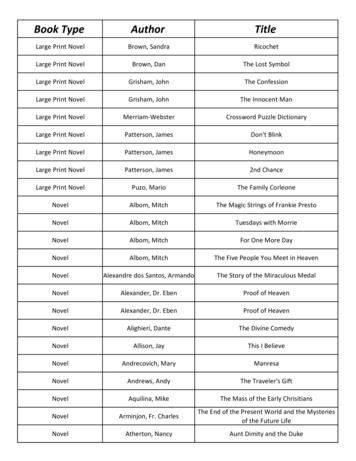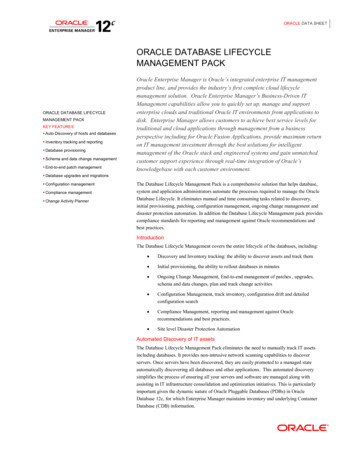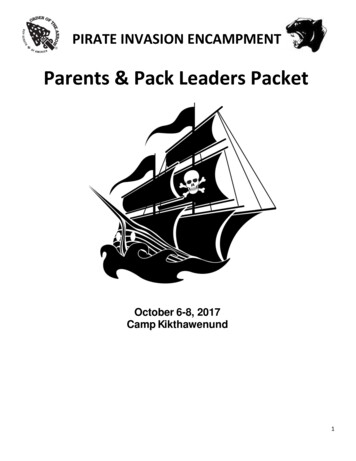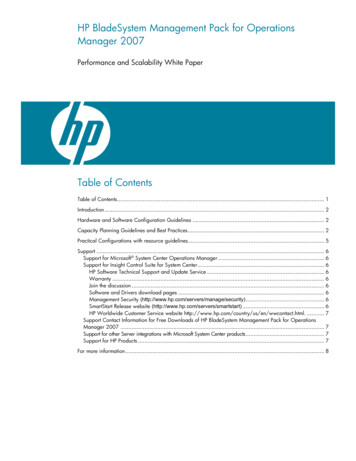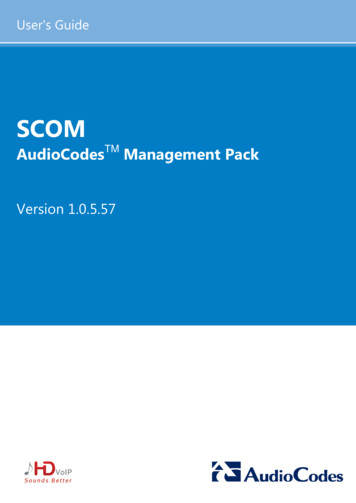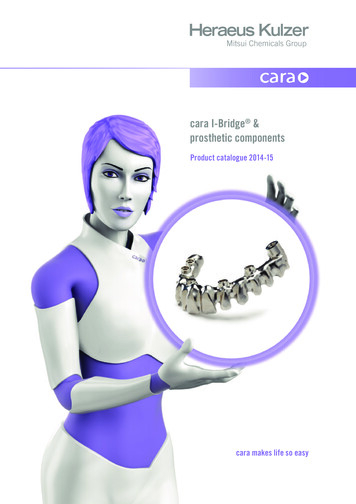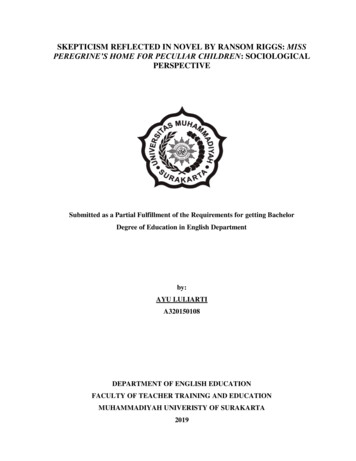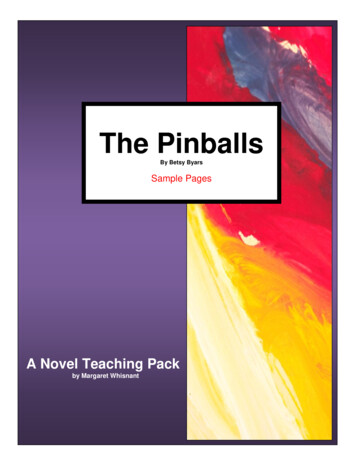
Transcription
The PinballsBy Betsy ByarsSample PagesA Novel Teaching Packby Margaret Whisnant
One summer, three childrencome to live in a foster home.Carlie,angry, intelligent,TV addict, a comedian,fighting back.Harvey,abandoned, sad,broken in body, broken in spirit,losing hope.Thomas J,without identity,without love,alone,searching for himself.Three children,The Pinballs,bounced around by the hand of fate,needing answers,needing purpose,needing each other.Copyright 2009 Margaret WhisnantTaking Grades Publishing Company, Conover, NC2
Copyright 2010 Margaret WhisnantThe Pinballsby Betsy ByarsA Novel Teaching Packby Margaret WhisnantISBN 978-1-934538-52-4Permission to copy for classroom use only.Electronic distribution limited to classroom use only.All rights reserved by author.Taking Grades Publishing CompanyConover, NC 28613Copyright 2009 Margaret WhisnantTaking Grades Publishing Company, Conover, NC3
An Introduction toYour Novel Teaching Pack. . .GoalsTo. . .Offer a teaching guide with a full spectrum of learning experiences that flow from basic knowledge tohigher-level thinking skills.Provide classroom-ready materials that motivate and instruct.Create novel-specific activities that require careful reading, help develop comprehension skills, andchallenge the thinking process.Accommodate a wide variety of student ability and interest.Support teachers by providing a practical teaching resource that saves preparation time.Include cross-curricula activities as an integral part of the novel study.Correlate to various state education standards and requirements for language arts.The Seven Components. . .1. SummariesWritten in present tense, the chapter-by-chapter summaries are more detailed than those found in mostteachers’ guides or other sources. Important points of the plot, character motivation and development, andstory clues are all included. For quick reference, the summaries are presented in bulleted format. Thesesynopses are a valuable resource forquickly becoming familiar with a title when time is limitedmanaging a reading program that involves multiple titles/reading groupsfacilitating independent studyrefreshing memory when using a novel from year to year.2. Before You ReadIn this component, the focus is on sparking student interest. Each teaching pack includes both anindependent activity and a series of whole-group/small-group discussion or research topics, written asopen-ended questions.At least one bulletin board idea is included. In some cases, activities in the Think, Write, Createcomponent also involve the creation of a bulletin board or classroom display.3. VocabularyOne of the many advantages of literature-based reading instruction is the opportunity to observevocabulary in action! It is this circumstance that drives the vocabulary portion of the novel teaching packs.Word Choices. . .The words lifted from the novel for focused study are chosen based on one or more of the followingcriteria:their level of difficultytheir frequency of use in children’s literaturetheir importance in comprehending the storytheir value as useful composition vocabularythe probability that they will be encountered acrossunique meanings, spellings, pronunciation, etc.the curriculumWord Lists and Definitions. . .For teacher convenience and reference, word lists with definitions are included. The selected words arearranged in story order, complete with page numbers so they can be spotted easily and studied in their“natural habitats.” For clarity, the definitions are paraphrased to match the word’s tense, number, part ofspeech, etc. rather than cross referenced as in a standard dictionary. The major resource of this informationis www.dictionary.com.Dictionary Activities. . .Long word lists are divided into chapter sets of workable numbers and presented as Dictionary Digs—sometimes given a slightly different name to correspond with the theme of the novel. In this introductorystage, students use a dictionary to answer a series of multiple choice questions about word meanings, usage,unique characteristics, etc.Copyright 2009 Margaret WhisnantTaking Grades Publishing Company, Conover, NC4
Using the Words. . .Other activities, which pull terms from the lists in random order, lead students through a variety of wordstudies which includesentence usageword types (acronyms, onomatopoeia, etc.)word formsscrambled sentencessynonyms and antonymsanalogiesanagramswhole-class/group gamescategoriesetymologiesword groups/connections4. AssessmentThe two sections in this portion of the teaching pack offer a wealth of materials designed to build a strong foundationfor student progression to higher level thinking skills. The operative phrase is basic comprehension.Short Answer QuestionsShort answer questions for each chapter (or groups of chapters) are the first available assessment tools.The items encourage (and check) careful reading. Some require the reader to recognize a major event oridea while others involve finding a minor detail. The questions are in sequence with the pages they cover, butthey are not designed to call attention to plot construction or other story elements.The short answer questions can be used asstudent reading guidesdiscussion groups guidespop quizzesconferencing with individual studentsObjective TestsThe objective tests have multiple functions. In addition to their obvious application, they also serve astools that can improve comprehension skills by providing practice in understanding plot structure andrecognizing important story elements.Rationale:Focus on the Plot. . .Whether they are aware of their ability or not, all good readers sense the rhythm of the connectedevents that compose the plot of a novel, and consequently comprehend the story. They are in tune withcause and effect, behavior and consequence, sequence—the heartbeat of the narrative.This “plot rhythm” forms the framework for the objective tests. The chain of events that tell the story havebeen pulled from the novel and reformatted into a series of sequential questions, none of which requireinterpretation. They are intended to draw student attention to the fact that something happened, not towhat the incident means. That comes later.In addition to their testing function, teachers may use the pages to strengthen their students’ ability toSummarize: With only the questions as a guide, have students write a summary of the chapter. For a set often questions, limit the number of sentences they may write to seven or fewer. When they work with twentyor more questions, allow no more than twelve sentences.Report the News: Ask your students to write a newspaper article based on the events identified in a set ofquestions and the who, what, when, where, why elements. Some information needed to complete thisassignment may be located in previous chapters.Twist the Plot: Choose one or two questions from each chapter and change its answer—true to false, no toyes, etc.—to demonstrate how changing a single (or several) events would (or would not) change the story.This process can be used to help students become proficient in distinguishing major plot movers from minorstory details.The Characters. . .Too often, when they are asked to describe a story character’s personality, the only answer manystudents can muster is “nice.” This portion of the Novel Teaching Pack, coupled with related activities fromThink, Write, Create, is a well of opportunities for those teachers who wish to eradicate “nice” from theirstudents’ vocabularies!Questions that identify a character’s personality and/or motivation are purposely and carefully includedwith the plot movers. Again, the questions do not require interpretation. They simply establish thatsomeone did or said something—knowledge that is invaluable when character analysis is required.Copyright 2009 Margaret WhisnantTaking Grades Publishing Company, Conover, NC5
Implied Meaning and Story Clues. . .The objective tests include items that establish the existence of story components carrying impliedmeaning. Story clues that tantalize the reader with hints of future events also appear as question. At thispoint in the novel study, as before, interpretation is not the goal. Awareness of the facts is the target.Developing/Improving Listening Skills. . .Listening skills are rightfully included on every list of state competency requirements. Rather than alwaysrequiring students to answer test questions on a printed page, why not surprise them occasionally by doingthe test orally and meeting competency goals at the same time?Discussion Guide Capability. . .The objective tests are helpful discussion guides. Use individual items on these pages to draw studentattention to sequence, cause and effect, story clues (foreshadowing), character traits, recognizing andinterpreting implied meanings, etc. These “thinking out loud” sessions are an important building block forthe next learning phase.5. Think, Write, CreateIn this section, students pack up what they already know about the novel and go exploring into its everynook and cranny. Some activities require the simplest interpretation or application, while others will challengethe most proficient thinkers. There is a high probability that young scholars, even reluctant ones, will labelsome of the selections as fun.Rationale:Guidelines. . .Most of the items in this section are based on the skills presented in the Taxonomy of EducationalObjectives (Bloom’s Taxonomy). There are two reasons for this choice. First, it mirrors the NovelTeaching Pack’s primary purpose of building a variety of sophisticated thinking skills on a foundation of basicknowledge. Second, in following the taxonomy guidelines, activities that correlate with many stateeducational standards emerge automatically.Organization. . .Chapter-specific activities are grouped and presented according to their corresponding sets of ShortAnswer Questions and Objective Test page(s). Having led students through the basics for each chapter (orselected section), teachers may shop in this section for in-depth activities to optimize student understandingand interest. Armed with a firm grasp of each successive chapter, students are more likely to anticipate,embrace, and enjoy the next section. By repeating the process, students are also mastering concepts andintricacies connected to the whole novelThe Whole Book Activities, as their name indicates, require a grasp of the theme(s), characters,implications, etc. as they apply to the full novel. These pages are a teacher’s smorgasbord of culminatingpossibilities. In some cases, the choices are outgrowths of concepts that students have dealt with in aprevious activity. In others, students are encouraged to look at the novel from a new angle.Levels of Difficulty. . .A broad spectrum of difficulty levels to accommodate the needs of individual students, including thegifted, is an integral part of Think, Write, Create. However, all items from this section are intended tochallenge and sharpen thinking abilities.Activities. . .Every novel teaching pack includes activities that require students to choose and use precise, appropriate,and meaningful vocabulary. These exercises involve choosing a group of words to describe a character’spersonality or behavior. The following example is from Charlotte’s Web.Eight-year-old Fern cried and begged her father not to destroy the runt pig. She sealed the little animal’s fate byasking her father if he would have killed her if she had been born very small.Which two of the following words do you think best describe the way Fern’s father behaved during this episode?Explain your choice. Include the definitions of the words you selected in your listicflexiblecallouscompassionate logicalChoose two words from the list below that you believe best describe Fern’s behavior. Explain why they arethe appropriate words. Use the definitions of your choices as part of your hearted icCopyright 2009 Margaret WhisnantTaking Grades Publishing Company, Conover, NC6
In each case students work with a given collection of terms, all of which can be correctly applied to thecharacter(s) in question. However, the individual words have strengths of meaning. It is the student’s task toanalyze both the character’s behavior and the words, make choices, and then cite events from the story tosupport his/her selection.Teachers may opt to narrow the choices to fewer words, choose words for individual students, divide theclass into groups and offer a specific set of words to each group, or use the assignment as it is written.Whatever the technique, it is here that the word nice can be knocked off the shelf, shattered on the floor, andswept out the door. No longer necessary. Useless. Gone!Other items in this section challenge students to . . .write for self-expression, for communication, andthink about social issuesfor entertainmentcreate drawings, diagrams, photos, maps,form opinions and theoriesmodels, recordings, films, etc.cite “evidence” from the story to support theirimagineexplanations and opinionscategorizeconnect personal experience to story situationsengage in research and data gatheringbecome familiar with and identify literary elementsrecognize and perceive story theme(s)analyze story characters and eventsunderstand point of viewmake predictions based on given factsCross Curricula. . .Think, Write, Create takes full advantage of opportunities to connect both major themes and the smalleststory detail to other realms of the curriculum. In Charlotte’s Web, for example, students may apply theircalculation skills to a page of “Spider Math.” In the Holes teaching pack is a challenge to create a game thatutilizes a “saved” group of Camp Green Lake’s holes.Options, options, and more options. . .Think, Write, Create is purposely bulging at the seams to give teachers pick-and-choose options forindividualizing assignmentshomeworkgroup workshort-term and long-term projectswhole class activitiesdifferentiating assignments for two or more classescapitalizing on student interest6. Graphic OrganizersIdeas for the graphic organizers are pulled from the chapter or whole book activities and expanded into awriting assignment. Priority is given to those topics that allow a student to relate personal experiences, makechoices, empathize with a story character, and/or imagine.Structure. . .The organizers do not repeat a set pattern of circles, squares, lines, etc., prescribed for a particular type ofwriting. Each one is tailored to a specific idea pulled from the novel. Structured directions for organizingthe topic support the student at this stage of the process so that writing is the major focus.Non-writing Organizers. . .Sometimes, students are enticed to stretch their imaginations by filling out “forms” or writing “diary entries.”One graphic organizer from Hatchet, for example, allows students to assume the persona of the pilot whorescued Brian by writing three entries into his log—the day before the rescue, the day of the rescue, and theday after the rescue. In the Holes Novel Teaching Pack, students become detectives and conduct a“background check” on Mr. Sir, recording their findings on the provided “official form.” In these cases,composition skills take a back seat to imagination, empathy, and pure enjoyment. Teachers may wish tocapitalize on student enthusiasm by asking for a written “report” based on the information entered on theforms.7. Answer KeysKeys for all items that require a specific answer are included in this section.A final note from the author. . .It is my personal wish that when the last page has been read, the last activity completed, and the last ideadiscussed, at least one of your students will ask, “What are we going to read next?”Copyright 2009 Margaret WhisnantTaking Grades Publishing Company, Conover, NC7 Margaret Whisnant
The PinballsBy Betsy ByarsA Novel Teaching PackTable of ContentsPage(s)Chapter Summaries . . . . . . . . . . . . . . . . . . . . . . . . . . . . . . . . . . . . . . . . . . . . . . . . 1-16Before You ReadCarlie’s TV Trivia . . . . . . . . . . . . . . . . . . . . . . . . . . . . . . . . . . . . . . . . . . . . . . . . . . 17-18Something to Think About/Research/Bulletin Board Ideas . . . . . . . . . . . . . . . . . . . 19-20VocabularyVocabulary List in Alphabetical Order . . . . . . . . . . . . . . . . . . . . . . . . . . . . . . . . . . . . . 21Vocabulary Lists with Definitions . . . . . . . . . . . . . . . . . . . . . . . . . . . . . . . . . . . . . . 22-23Dictionary Digs . . . . . . . . . . . . . . . . . . . . . . . . . . . . . . . . . . . . . . . . . . . . . . . . . . . .24-27Anagram Scramble . . . . . . . . . . . . . . . . . . . . . . . . . . . . . . . . . . . . . . . . . . . . . . . . .28-29Word Families . . . . . . . . . . . . . . . . . . . . . . . . . . . . . . . . . . . . . . . . . . . . . . . . . . . . . . . 30Short Answer Questions . . . . . . . . . . . . . . . . . . . . . . . . . . . . . . . . . . . . . . . . . . . .31-34Objective TestsChapter TestsChapter 1—Chapter 2. . . . . . . . . . . . . . . . . . . . . . . . . . . . . . . . . . . . . . . . . . . . . . . . . . . . . . . .35Chapter 3—Chapter 4. . . . . . . . . . . . . . . . . . . . . . . . . . . . . . . . . . . . . . . . . . . . . . . . . . . . . .36-37Chapter 5—Chapter 6 . . . . . . . . . . . . . . . . . . . . . . . . . . . . . . . . . . . . . . . . . . . . . . . . . . . . . . . .38Chapter 7—Chapter 8 . . . . . . . . . . . . . . . . . . . . . . . . . . . . . . . . . . . . . . . . . . . . . . . . . . . . . . . .39Chapter 9—Chapter 10 . . . . . . . . . . . . . . . . . . . . . . . . . . . . . . . . . . . . . . . . . . . . . . . . . . . .40-41Chapter 11—Chapter 12 . . . . . . . . . . . . . . . . . . . . . . . . . . . . . . . . . . . . . . . . . . . . . . . . . . 42-43Chapter 13—Chapter 14 . . . . . . . . . . . . . . . . . . . . . . . . . . . . . . . . . . . . . . . . . . . . . . . . . . 44-45Chapter 15.—Chapter 16 . . . . . . . . . . . . . . . . . . . . . . . . . . . . . . . . . . . . . . . . . . . . . . . . . . .46-47Chapter 17—Chapter 18 . . . . . . . . . . . . . . . . . . . . . . . . . . . . . . . . . . . . . . . . . . . . . . . . . . 48-49Copyright 2009 Margaret WhisnantTaking Grades Publishing Company, Conover, NC1
Table of Contents—continuedChapter 19—Chapter 20—Chapter 21. . . . . . . . . . . . . . . . . . . . . . . . . . . . . . . . . . . . . . 50-51Chapter 22—Chapter 23 . . . . . . . . . . . . . . . . . . . . . . . . . . . . . . . . . . . . . . . . . . . . . . . . . . . 52Chapter 24—Chapter 25—Chapter 26 . . . . . . . . . . . . . . . . . . . . . . . . . . . . . . . . . . . . . .53-54Whole Book Test . . . . . . . . . . . . . . . . . . . . . . . . . . . . . . . . . . . . . . . . . . . . . . . . . . . .55-56Think, Write, CreateChapter-by-Chapter . . . . . . . . . . . . . . . . . . . . . . . . . . . . . . . . . . . . . . . . . . . . . .57-70Whole Book . . . . . . . . . . . . . . . . . . . . . . . . . . . . . . . . . . . . . . . . . . . . . . . . . . . 71-75Graphic OrganizersThree Children . . . . . . . . . . . . . . . . . . . . . . . . . . . . . . . . . . . . . . . . . . . . . . . . . . . .76How to Mind Your Own Business When Everything You AreInterested in Is Your Business . . . . . . . . . . . . . . . . . . . . . . . . . . . .77The Awesome Twosome . . . . . . . . . . . . . . . . . . . . . . . . . . . . . . . . . . . . . . . . . . . 78A Successful Gift . . . . . . . . . . . . . . . . . . . . . . . . . . . . . . . . . . . . . . . . . . . . . . . . 79Carlie and Thomas J’s Really Nice Birthday . . . . . . . . . . . . . . . . . . . . . . . . . . . .80Mr. and Mrs. Mason, Foster Parents Extraordinaire . . . . . . . . . . . . . . . . . . . . . .81Thomas J’s Fifteen Minutes of Fame—A Scenario . . . . . . . . . . . . . . . . . . . . . . .82The Eccentric Benson Twins . . . . . . . . . . . . . . . . . . . . . . . . . . . . . . . . . . . . . . . .83Carlie’s Transformation: A Study of “I’ll Be Glad To.” . . . . . . . . . . . . . . . . . . . . .84Harvey’s Best Sellers . . . . . . . . . . . . . . . . . . . . . . . . . . . . . . . . . . . . . . . . . . . . . 85Keys. . . . . . . . . . . . . . . . . . . . . . . . . . . . . . . . . . . . . . . . . . . . . . . . . . . . . . . . . . . . . . . . . 86-91Copyright 2009 Margaret WhisnantTaking Grades Publishing Company, Conover, NC2
SummariesThe PinballsBy Betsy ByarsChapter Summaries1One summer two boys and a girl go to a foster home to live together.One of the boys is Harvey. Both of his legs are broken because his father ran over him witha car.When Harvey wins third prize of two dollars for his essay, “Why I Am Proud to Be anAmerican,” his father promises to drive him to the meeting to see him get the award.The winners and their parents will have their pictures in the newspaper.On the night of the awards, Harvey sits waiting in the car for his father. He cannot believe itwhen the man tells him to get out of the car. He is late for his poker game at the Elks Club.Harvey reminds his father of his promise, but the man denies having promised Harveyanything. He leans over and pushes his son out of the car. When Harvey grabs for the cardoor, the red-faced man locks it.Harvey runs around the front of the car to try to open the other door. His father accidentallythrows the car into drive instead of reverse and steps on the gas. The Trans Am runs overHarvey and breaks both his legs.The court takes Harvey away from his father and puts him in the foster home until his fathercan control his drinking and give the boy a safe home.The second boy is Thomas J. He doesn’t know anything about his family. At the age of two,he had been dropped off in front of the Benson twins’ farmhouse. They are eighty-two yearsold, and the oldest twins in the state. Thomas J stays with them for six years.The Bensons mean to take Thomas J to town to the authorities, but he is pleasant company.He is also good help in the garden. When the twins both fall and break their hips at the ageof eighty-eight, the authorities discover Thomas J. He is sent to the foster home until hisidentity can be established or permanent adoptive parents can be found.The girl is Carlie. She never says anything polite. She throws things at people who blockher view when she is watching television, which is her main fun.Carlie has had two stepfathers, but Russell is the worst. She has been sent to the fosterhome because she can’t get along with him.Once Russell hit Carlie so hard, she got a concussion. Before she collapsed, she hadmanaged to hit him back with a double boiler. She has to stay at the foster home until herown home situation stabilizes.The first thing Carlie does at the Masons’ is pull the plastic footrest up close to the TV andwarn Mrs. Mason not to talk to her when “Young and Restless” is on. Her foster mother canwelcome her during the commercial.2Carlie has been suspicious of people since the day she was born. She believes everyone isout to do her in. She dislikes Mrs. Mason, the foster mother, as soon as she sees herstanding in the doorway. She tells the social worker that the woman is trying to copy Mrs.Walton (Note: character from 1971-1981 TV series “The Waltons”) by wearing an apron, butshe is not fooled by such things.Carlie is especially disturbed by the Masons’ living room, where there are seventeenpictures, probably of foster children. Carlie vows that her picture will not go up over thefireplace with the others.Mrs. Mason waits until “Young and Restless” is over to ask Carlie to come have somelunch. Afterwards, they will get the boys’ room ready. Carlie is interested.The boys are eight and thirteen—too young for Carlie. Mrs. Mason says the boys will haveto tell Carlie about their troubles. All she knows is that the thirteen-year-old has two brokenlegs.Carlie says that lets out dancing.Copyright 2008 Margaret WhisnantTaking Grades Publishing Company, Conover, NC 286133
VocabularyThe PinballsBy Betsy Byars(30 words)Set Two: Chapter 8—Chapter 26Some words may appear on more than one pageconcentrate To think about closely; to direct one’s thoughts or attention to, as a project at hand ora goal. (p. 40)summoned Called forth; requested to appear; sent for; paged; law: ordered to appear in court bythe issuance of a summons. (p. 41)boutique A small retail shop that specializes in gifts, fashionable clothes, accessories, food, etc.; asmall shop located within a large department store or supermarket. (p. 43)addicted Dependent on something; to be mentally or physically dependent on a substance,especially one that is habit-forming such as nicotine or chocolate; hooked. (p. 45)tottering Walking unsteadily or shakily; swaying as if about to fall. (p. 52)shriveled Dried up; having lost all moisture; shrunken and wrinkled, often by drying from lack ofmoisture; lost vitality or intensity; dehydrated; dry. (p. 55)abandoned Left alone; deserted; forsaken; gave up or left. (p. 56)principle A belief or fundamental law that one lives by; an accepted rule or standard, especially ofgood behavior; a fundamental, primary, or general law or truth from which others arederived; a matter of principle—making decisions based on one’s beliefs or rules ofconduct. (p. 60)persuaded Convinced; asked a person to do something by appealing to reason or understanding;influenced; motivated; won over. (p. 63)mugged Assaulted or threatened, especially for the purpose of robbery; made exaggeratedfacial expressions, especially in acting or being photographed. (p. 65)criticized Found fault with; judged unfavorably or harshly; made judgments as to the merits orfaults of; judged. (p 69)casserole A baking dish of glass, pottery, or cast iron usually with a cover, in which food is bothbaked and served; any food, usually a mixture of ingredients, cooked in such a dish; acovered dish. (p. 69)sulked Displayed an attitude of silent resentment, anger, or protest; pouted; brooded. (p. 69,sulking p. 93)astonished Filled with sudden wonder or amazement; amazed; dumbfounded; aghast. (p. 71)fidget To move about nervously, impatiently, or restlessly; fret. (p. 74)juvenile Young; not fully developed or grown; marked by immaturity or childish behavior. (p. 78)hunched Having the back and shoulders in a rounded position; in a crouched or cramped posture;bent or drawn up into a hump. (p. 84)wavered Trembled in sound, as of the voice or a musical note; quivered; moved unsteadily backand forth; fluctuated. (p. 93)feeble Physically weak, as from age or sickness; frail; lacking in strength, force, or effectiveness;not strong; faint.(p. 94)mutely Silently; refraining from speaking; not emitting or having sound of any kind; (p. 95)agonized Marked by great pain or anguish; made or done with great effort; distressed; suffered;lamented. (p. 101)nudged Pushed slightly or gently, especially with the elbow, to get someone’s attention or prodinto action; bumped; elbowed; tapped; pestered. (p. 108)furious Extremely angry; raging; full of activity; energetic or rapid; livid; vehement. (p. 113)cahoots A secret partnership, especially one for the purpose of questionable activity. (p. 114)commotion A noisy disturbance; hubbub; disorder; a condition of turbulent motion. (p. 120)blurt To speak out suddenly, especially with emotion; burst out; babble; reveal. (p. 125)hacking Making rough cuts or notches; dealing cutting blows; coughing harshly, usually in shortand repeated spasms; chopping; mutilating. (p. 129)uncomplimentary Not favorable or appreciative; expressing a low opinion or; derogatory;belittling. (p. 129)admiration Great respect; the act of looking upon or thinking about with pleasure; a feeling ofwonder, pleasure, or approval; delight; honor. (p. 133)snubbed Ignored or behaved coldly toward; treated with distain or contempt. (p. 134)Copyright 2008 Margaret WhisnantTaking Grades Publishing Company, Conover, NC 286134
VocabularyThe PinballsBy Betsy ByarsDictionary DigsChapter 1—Chapter 7Dig into your favorite dictionary to answer the following questions about some important words fromChapters 1 through 7 of The Pinballs. Write the letters of the correct answers in the blanks to the left.1. A synonym for hesitated is (A) faltered, (B) surged, (C) resolved.2. Which of the following phrases is not a good example of the correct use of the wordforge? (A) forge a signature, (B) forge through a mountain of homework, (C) forge asong for his own entertainment.3. The correct spelling of the word meaning to come to be without is (A) loose, (B) lose,(C) louse.4. Which word can be substituted for resented in the following sentence so that it ischanged to an opposite meaning?Isaiah stood expressionless, trying to hide the fact that he resentedevery word Mrs. Nieman spoke.(A) savored, (B) begrudged, (C) disdained5. To say that someone has a superior attitude means that the person (A) fancies himselfto be better than another or others, (B) has a healthy self-esteem, (C) doesn’t care.6. Something not likely to have hovered in midair is (A) a UFO, (B) a hummingbird, (C) afast-pitched softball.7. A majorette is (A) a male drummer in a marching band, (B) a female baton twirler whoaccompanies a marching band, (C) any uniformed member of a marching band.8. Which of the following caricatures is the best example of a facial expression that could beinterpreted as suspicious?(A)(B)(C)9. A word that is an antonym of stabilizes is (A) equalizes, (B) varies, (C) balances.10. An incorrect definition of the word commune is (A) to begin on schedule, especially avital undertaking, (B) to talk together, (C) a small group of people living together andsharing work, possessions, income, etc.11. A tiger is most likely to be in a crouched position when it is (A) sleeping, (B) hunting,(C) running.12. The authorities are people who (A) have
The Pinballs by Betsy Byars A Novel Teaching Pack by Margaret Whisnant . Summarize: With only the questions as a guide, have students write a summary of the chapter. For a set of ten questions, limit the number of sentences they may write to seven or fewer. . The Whole Book Activities, as their name indicates, require a grasp of the theme(s
